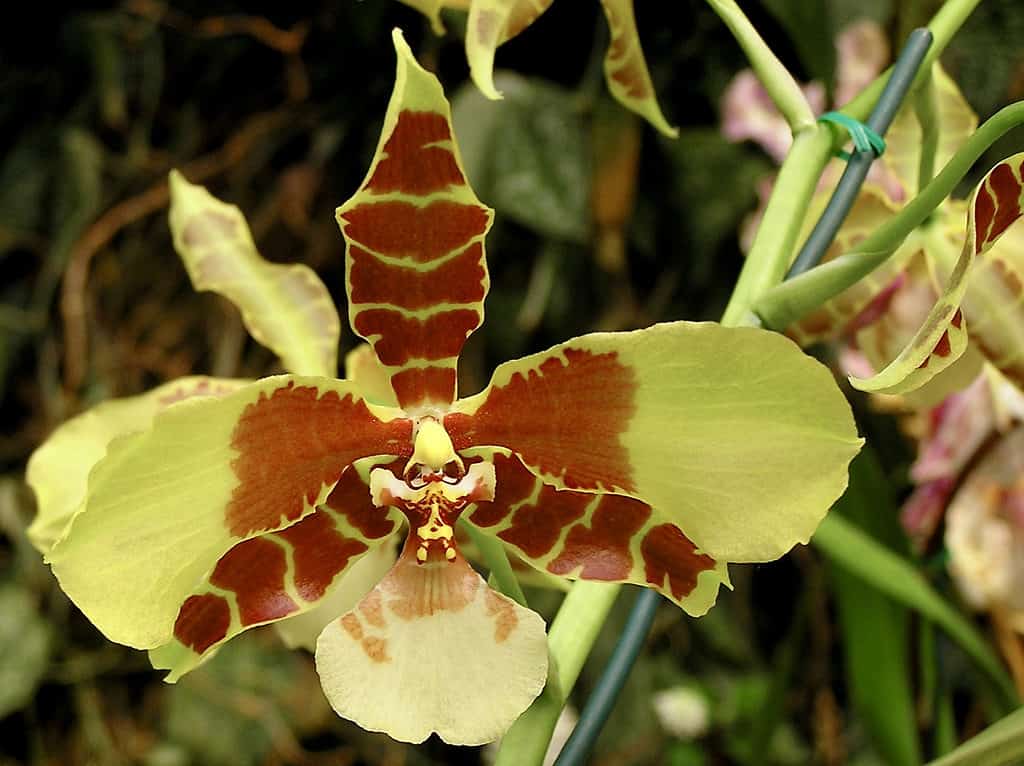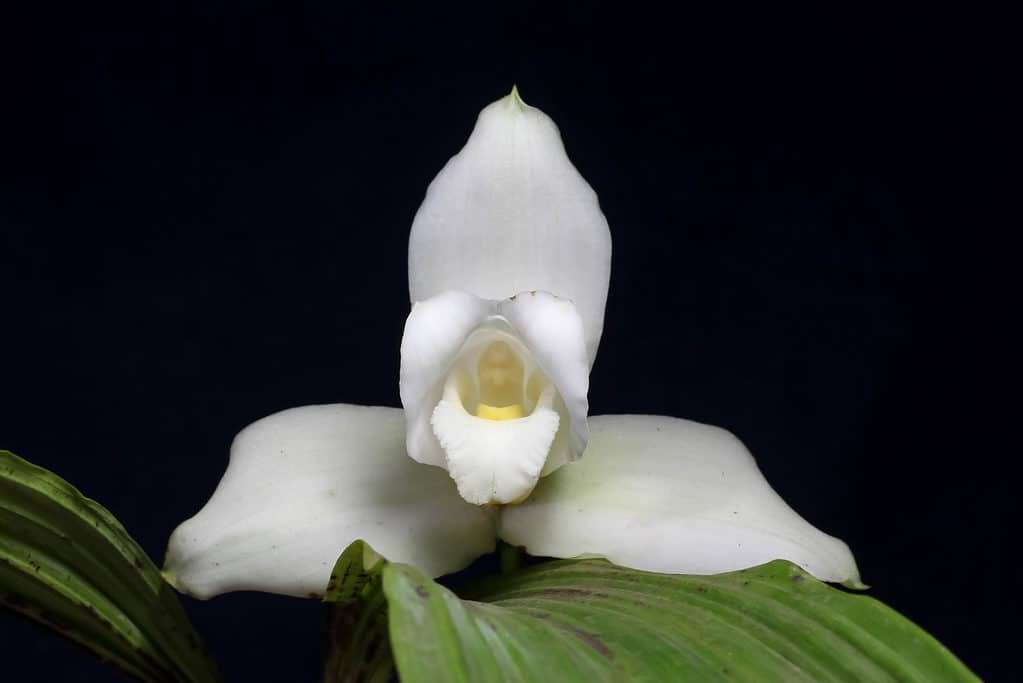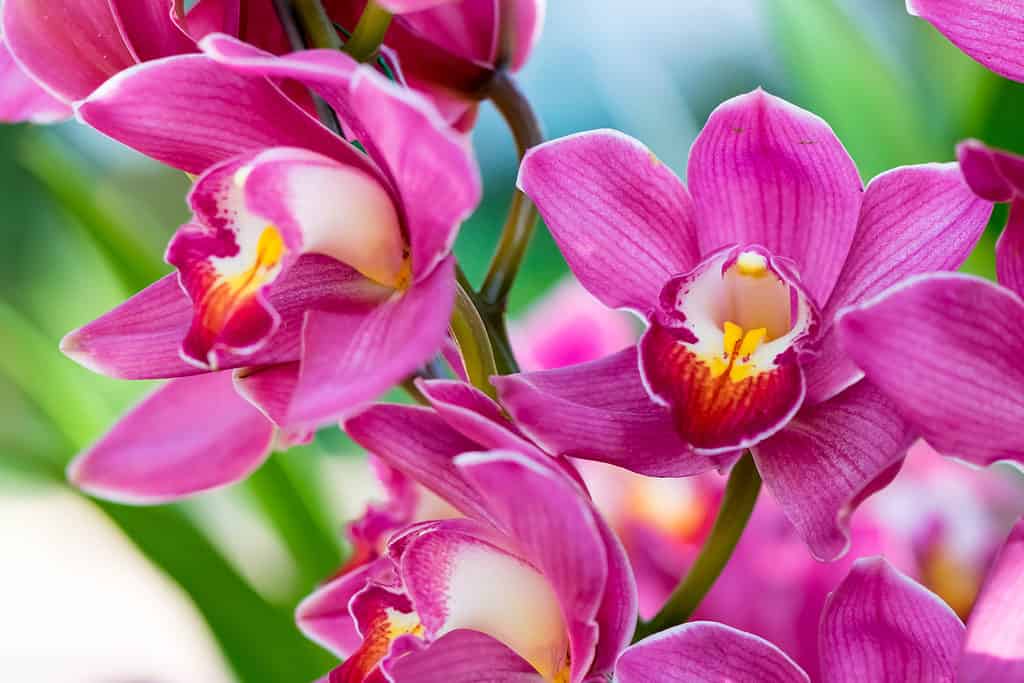If you’re starting to learn about the basics of orchid growing, you may be coming across quite a bit of literature dedicated to the complexities of orchid fertilizing. You’ll find that a basic understanding of this subject will suffice for growing many beginner-friendly species and genera of orchids and that as your understanding of orchid fertilizing grows, you’ll be able to produce magnificent blooms on trickier species and cultivars.
In this guide, we’ll focus on making sure you have a solid orchid fertilizing foundation to get you started in caring for these magnificent plants. As you learn below, there’s no one-size-fits-all answer to fertilizing orchids; rather, it’s crucial to learn about the major types of orchids, how they grow in nature, and how they naturally receive nutrients. From there, you can provide appropriate fertilizing that best meets the needs of a specific genus or species.
Alright, let’s get into the nitty-gritty of this important orchid topic!
Orchids: Botanical Classification

Tiger
mouth orchid (
Rossioglossum grande).
©NasserHalaweh, CC BY-SA 4.0 <https://creativecommons.org/licenses/by-sa/4.0>, via Wikimedia Commons – Original / License
First off, let’s discuss how orchids are classified and what environments they naturally inhabit. Orchids belong to the Orchidaceae family, which currently contains almost 30,000 species across 880 genera. This enormous number of species makes up roughly 10% of all flowering plant species on Earth. Not only are these plants numerous, but they’re highly diverse. Evolving over 100 million years to thrive as masters of adaptation, orchids now grow in various habitats on every continent except Antarctica.
These brilliant plants even figured out how to succeed in growing on rocks (lithophytic), leaf litter (semi-terrestrial), and attached to tree bark (epiphytic). When orchids evolved to live on the bark of trees at various altitudes, their diversification increased by a whopping 20%. They so thoroughly filled this epiphytic niche that now 80% of all orchid species live as epiphytes.
So, what does this mean for fertilizing your orchid? Find out more below.
Orchid Fertilizer: Do They Need It?

The white nun orchid is Guatemala’s national flower.
©Arielvelasquez0896/Shutterstock.com
The short answer to this question is yes. Most orchids in cultivation require consistent fertilizing to thrive and bloom. This is especially true for epiphytic and lithophytic orchids during their growth phase.
So, why do these orchids, in particular, need consistent feeding? Because, unlike terrestrial species, they don’t have extensive root systems. This prevents orchids from taking up the soil’s larger store of nutrients. Instead, epiphytic and lithophytic orchids rely on nutrients from debris on the rock, bark, and moss they attach to. Some species also contain specialized hairs called trichomes that help uptake nutrients directly from the air.
They also rely heavily on symbiotic relationships with beneficial fungi to obtain natural nutrients. These fungi deliver nutrients to the roots of the orchid in exchange for sugar, which the plants create during photosynthesis. One in-depth study on epiphytic orchids and their fungi partners suggests that this relationship is crucial for tree-dwelling orchids. This is because epiphytes living on tree bark have less water and nutrient availability.
In cultivation, fertilizers compensate for this lack of nutrient-rich debris that the orchids can access.
Terrestrial orchids also form beneficial plant-fungi relationships that assist them in attaining the nutrients they need to thrive. Fertilizing terrestrials helps to make up for the lack of this partnership in cultivated orchids and compensate for potted soil nutrient depletion over time.
Fertilizing Epiphytic and Lithophytic Orchids

Close-up of Schiller’s moth orchid,
Phalaenopsis schilleriana.
©PAUL ATKINSON/Shutterstock.com
When fertilizing non-terrestrial orchids, it’s important to follow a few basic guidelines:
- Fertilize weakly, but often during the growth phase.
- Avoid urea-only nitrogen
- Fertilize when substrate and roots are moist.
- Take into account the TDS measurement of the water source.
- Reduce or eliminate fertilizing if the plant goes through dormancy.
We’ll break down these concepts in depth below. You’ll find that points 2-5 are also useful in fertilizing terrestrial orchids as well.
1. During the Growth Phase, Fertilize Weakly Weekly
You may have come across the phrase “fertilize weakly weekly” in relation to feeding orchids, especially non-terrestrial species. For most epiphytic and lithophytic orchids, you’ll want to provide weekly feeding of liquid orchid fertilizer at 1/4-1/2 the strength of the recommended dose. Suppose the species you’re growing enters a dormant phase. In that case, you’ll typically want to cut back to fertilizing once a month. You can also eliminate it entirely because the roots don’t uptake nearly as many nutrients when dormant. If you don’t cut back, you risk burning the plant roots with fertilizer that they won’t uptake.
2. Avoid Urea-Only Nitrogen
You’ll want to avoid using products that contain urea as the only nitrogen source, especially for mounted orchids, because urea is easily flushed through the growing substrate and cannot be quickly converted into available nutrients by the microbes living in the growing substrate. Orchids that grow mounted on bark slabs or in inorganic-based mixes have far less of a microbial community than orchids grown in an organic soil-less potting mix or soil-based mix. In this context, we’re referring to organic as compounds containing carbon atoms and inorganic meaning compounds that lack carbon atoms, such as perlite.
You’ll want to opt for orchid fertilizers that contain more than half of its nitrogen as nitrate rather than ammonium or urea. The bags on fertilizers should state what source of nitrogen they’re using.
3. Fertilize When the Substrate and Roots are Moist
Dry orchid roots, especially of the non-terrestrial species, are susceptible to burns from fertilizer exposure. It’s best to use a liquid-soluble fertilizer added to the plant directly after watering. This helps prevent the damage that dry-application fertilizing can cause to the sensitive roots.
4. Take TDS into Account
TDS stands for “total dissolved solids” and is a measurement of the solid substances dissolved in water that are less than 2 microns in size. These solids include chemical elements like carbon and nitrogen, salt, potassium, magnesium, and chlorine minerals, and metals such as iron, copper, and nickel. TDS can be recorded as the number of milligrams of dissolved solids in 1 liter of water (mg/liter) or as parts per million (ppm measurement based on 1 million milligrams in 1 liter of water).
When fertilizing sensitive orchids with liquid fertilizer, you’ll want to know the TDS level of the water source you’ll be adding the fertilizer. Generally, for non-terrestrial orchids, it’s best to add fertilizer to water that contains less than 175 ppm (or 175mg/liter).
5. Reduce or Eliminate Fertilizer when the Orchid is Dormant
Orchids that don’t live in areas with consistent year-round temperatures tend to enter into a dormant phase in the late fall-winter. You’ll want to significantly reduce or eliminate feedings during this time, as the roots will not uptake nearly as many nutrients as they do during the growing phase. Generally, fertilizing in the winter is cut back to once a month.
Fertilizing Terrestrial Orchids

Close-up of Thailand Cymbidium hybrid orchids.
©Sealstep/Shutterstock.com
Terrestrial orchids grown in a humus-rich potting mix require less frequent fertilizing than epiphytic and lithophytic orchids. Depending on the species, you can fertilize every one to two weeks with these orchids at about 1/4-1/8 the recommended dose. Or you can periodically add compost or leaf litter into your terrestrial orchid potting mix.
Some growers will also add a pinch of fish emulsion or similar organic fertilizer into their mix once each spring and summer to support vigorous growth. Slow-release fertilizers are also popular with terrestrial species, rather than weekly diluted feedings, since the nutrients can break down into the potting mix. Growers typically apply these once every 2-3 months.
Less is definitely more with most terrestrial orchids as they gain most of the nutrients that they need from their potting mixes, and additional over-fertilizing can quickly lead to root burn. For most terrestrial species, you’ll want to cut back entirely on feeding during dormancy and only start again once new growth emerges.
Since terrestrial orchids grow in the soil, they can handle higher TDS levels. Generally, most of these species will thrive if you use liquid fertilizer mixed into water that contains TDS levels at or below 525 ppm.
The photo featured at the top of this post is © Kolinchev Andrii/Shutterstock.com
Thank you for reading! Have some feedback for us? Contact the AZ Animals editorial team.







